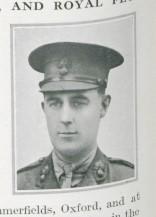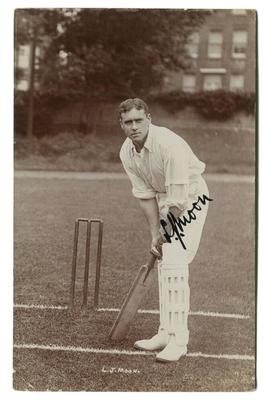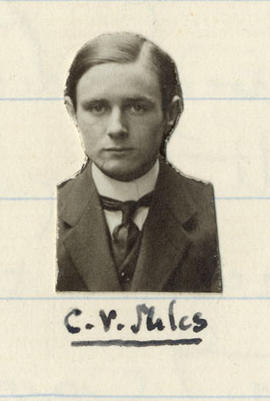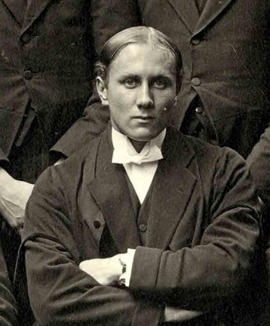Muriel, Sidney Herbert Foster, only son of the Rev. William Carter Muriel, Vicar of Fulham, by Lucie, daughter of Edmond Foster, of Cambridge; b. Sept. 9, 1877; adm. May 8, 1891 (H); left Dec. 1894; R.M.C. Sandhurst Sept. 1896; 2nd Lieut. Border Regt. Feb. 16, 1898; Lieut. Aug. 27, 1901; Adjt. Oct. 1, 1904 - Sept. 30, 1907; Capt. April 13, 1909; Adjt. (T.F.) April 13, 1909 - April 12, 1912; served in South Africa 1899-1902; mentioned in despatches L.G. July 29, 1902; served in Great War I; killed in action at Sed-el-Bahr, in the Dardanelles, April 30, 1915; unm.
Moxon, Gerald John Mortimer, only son of J. P. Moxon, by a daughter of Major Francis Drake, Northumberland Fusiliers; b. Nov. 22, 1893; adm. Sept. 24, 1908 (A); left July 1911; 2nd Lieut. 7th Batt. Royal Fusiliers Oct. 1, 1913, attached 4th Batt. Sept. 1, 1914; temp. Lieut. Feb. 11, 1915 - April 30, 1915; Lieut. May l, 1915; temp. Capt. July 9, 1915; went out to the western front Sept. 1914 and was wounded Oct. 20, 1914, and invalided home; rejoined 7th Batt. Royal Fusiliers and returned to the front in March 1915; killed in action at St. Eloi, France, March 27, 1916.
Morrison, Kenneth Rae, son of William Rae Morrison, of Hampton, Middlesex, by Lily Dawtry, of Petworth, Sussex; b. Dec. 16, 1896; adm. Jan. 18, 1912 (A); left Dec. 1912; enlisted in H.A.C. Aug. 1914; 2nd Lieut. Middlesex Regt. Dec. 18, 1914, 5th Batt. King's Royal Rifle Corps April 26, 1917; went out to the western front 1916; treacherously killed at Tower Hamlets, France, Sept. 21, 1917, by a German who had previously surrendered.
Morrall, Edgar Percy Basil, only son of Lieut.-Col. Abel Edgar Morrall, South Wales Borderers, by Annie, only daughter of George Townsend; b. Aug. 9, 1884; adm. April 23, 1896 (A); left July 1897; Lieut. Border Regt. Oct. 14, 1914; Capt. 9th Serv. Batt. (Pioneers) Feb. 23, 1915; acting Major; went out to the western front in 1915, thence to Serbia; invalided from Salonika and returned to England Aug. 1916, went out again to the western front early in 1917; m. Rose Ethel, daughter of John Macdonough, M. D., of Killarney, Ireland; killed in action near Arras, France, July 28, 1917.
Morgan, Albert Ernest, only son of Albert Charles Frederick Morgan, of Bayswater; b. May 24, 1889; adm. Sept. 25, 1902 (G); left July 1905; 2nd Lieut. 6th Batt. (Spec. Res). Royal Fusiliers May 22, 1911; Lieut. June 29, 1913; Flying Officer R.F.C. Sept. 12, 1914; asst. instructor at Upavon, Royal Flying School; went out to the western front Dec. 30, 1914; killed near Neuve Chapelle, France, in an aeroplane brought down by shell-fire March 10, 1915.
Moon, Leonard James, brother of William Robert Moon (q.v.); b. Feb. 9, 1878; adm. May 8, 1891 (G); left July 1896; Pembroke Coll. Camb., matric. Michaelmas 1896; B.A. 1900; M.A. 1912; played football (assoc.) for Cambridge 1898-1900, and cricket 1899 and 1900; played cricket for Middlesex 1899 and 1900, and for England v. S. Africa 1905; Head Master of Wellesley House School, Broadstairs, Kent; enlisted in the Inns of Court O.T.C.; 2nd Lieut. 10th (Serv.) Batt. Devon Regt. Feb. 10, 1915; served in France; d. Nov. 23, 1916, of wounds received at Salonika, Greece.
Montefiore, Langton, brother of Leslie Montefiore (q.v.); b. April 6, 1904; adm. Sept. 26 1918 (A); left Easter 1922; admitted a member of the London Stock Exchange 1927; 2nd Lieut. R.A.S.C. March 30, 1940; Capt.; m. June 2, 1927, Millicent, daughter of S. Lazarus, of St. Marylebone; killed on active service in Greece 27 April 1941.
Langton Montefiore was born at Chartridge, Buckinghamshire on the 6th of April 1904 the second son of Harry John Montefiore, a stockbroker and member of the London Stock Exchange, and Harriet (nee Montefiore) Montefiore of Chartridge Grange, near Chesham, later of “Fingest”, near Henley-on-Thames in Oxfordshire.
He was educated at Westminster School where he was up Ashburnham from the 26th of September 1918 and Easter 1922. He was a member of the Debating Society in 1921. He was a member of the Officer Training Corps and was promoted to Corporal in September 1921. On leaving school he went to work as a stockbroker and was admitted as a Member of the London Stock Exchange in 1927. He was married at Marylebone on the 2nd of June 1927 to Millicent (nee Lazarus) and they lived at 80, Eaton Place in London and at “Valley Holme”, Horsted Keynes in Sussex. They had a son, born on the 6th of May 1928. Following the outbreak of war he was appointed as a Deputy Area Officer for Air Raid Precautions. He was commissioned as a 2nd Lieutenant in the Royal Army Service Corps on the 30th of March 1940.
At 7pm on the 24th of April 1941, a convoy of trucks of the 308th Reserve Motor Transport Company, Royal Army Service Corps left Argos, Greece to head for Kalamata where they were to be evacuated to Egypt following the collapse of the Allied resistance to the German invasion of Greece. Driver T/199458 F.G. Lee reported that Major James Garrard Black, 2nd Lieutenant J.M. Carroll Lieutenant Mansfield, Langton Montefiore and about 100 men were among those who remained at Argos from where they made their way to the beaches in Nauplia Bay to await evacuation to Crete. They boarded the 11, 636 ton passenger liner SS Slamat, under the command of Master Tjalling Luidinga, on the night of the 26th/27th of April and set sail at 4.15am on the 27th of April. SS Slamat sailed south as part of a convoy and was in the Argolic Gulf when the convoy was attacked firstly by Messerschmitt Bf109 fighters and then by Junkers 87, Junkers 88 and Dornier 17 bombers at 7.15am. During the attack SS Slamat was struck between the bridge and the forward funnel by a 550lb bomb and was set on fire. As she listed to starboard, she was hit by a second bomb and the order was given to abandon the ship. With many of life boats and life rafts having been destroyed in the bombing, most of the survivors swam clear of the sinking ship with two overcrowded life boats capsizing. Some of the survivors were machine gunned in the water by enemy fighters. The destroyer HMS Diamond began taking survivors on board but was forced to stop and speed away when she too came under attack from enemy aircraft. HMS Diamond returned at 8.15am to rescue more survivors and at 9.16am the destroyer HMS Wryneck was ordered to join her in the rescue of the men in the water. At 9.25am HMS Diamond reported that she had picked up most of the survivors and was heading for Souda Bay but, when HMS Wryneck joined HMS Diamond at 11am both of the destroyers returned to SS Slamat where they found two more lifeboats and rescued their occupants. With SS Slamat on fire from stem to stern, she was scuttled by HMS Diamond with a single torpedo before the destroyer left the area with around 600 survivors on board. It is believed that Langton Montefiore was among those who were rescued from the water by the two destroyers.
At 1.15pm, a formation of Junkers 87 “Stuka” dive bombers attacked the two destroyers from out of the sun,with two bombs landing on HMS Diamond destroying her lifeboats and she sank eight minutes later. HMS Wryneck was hit by three bombs and sank ten to fifteen minutes later.
About 1,000 men were lost in the bombing of the three ships with only eight from the five hundred evacuees on board SS Slamat surviving the sinkings.
He is commemorated on the Athens Memorial Face 8.
Miles, Cyril Vernor, second son of Edward Vernor Miles, of Hampstead, solicitor, by Gertrude, daughter of Alfred Crosfield, of Liverpool; b. Aug. 5, 1892; adm. Sept. 28, 1905 (G); left July 1911; Pembroke Coll. Camb., matric. 1911; 2nd Lieut. 3rd Batt. (Res.) South Wales Borderers Aug. 15, 1914; attached Welsh Regt. Feb. 15, 1915; Capt. July 29, 1915; went out to the western front March 1915; killed in action at Hulloch, near Loos, Sept. 26, 1915; unm.
Miles, Alfred Crosfield Vernor, brother of Cyril Vernor Miles (q.v.); b. Aug. 31, 1894; adm. Sept. 24, 1908 (G); K.S. (non-resident) 1909; left July 1913; articled to his father Sept. 1913; enlisted in 1st Batt. Artists' Rifles Aug. 1914; 2nd Lieut. 2nd Batt. Welsh Regt. April 23, 1915; went out to the western front Oct. 1914; killed while acting as Brigade Wiring Officer, near Vermelles, in France, Aug. 24, 1915; unm.
Meyer, Edward Stirling, son of William Charles Bernhard Meyer MD FRCS and Alice Elizabeth Stirling, writer, d. of Col. Alexander Surlmg, Black Watch, of Perth; b. 8 Dec. 1920; adm. Sept. 1933 (KS); Capt. of the school 1938-9; left July 1939; Ch. Ch. Oxf., matric. 1939; Black Watch 1941-4 (Capt.), wounded, despatches (Middle East) Jan. 1944; killed in action (NW Europe) 1944.
Edward Stirling Meyer was born at Marylebone, London on the 8th of December 1920 the elder son of Dr William Charles Bernard Meyer BA MB Ch.B FRCS, a surgeon, and Alice Elizabeth (nee Stirling) Meyer MA, a writer, of 215, North End Road, West Kensington in London. He was educated at the Froebel Institute, Westminster and at Westminster School where he was admitted as a King’s Scholar from September 1933 to July 1939. He was awarded the Science VI Form Prize in 1936. He was a member of the Cricket XI in 1938 and 1939 and was a member of the Rowing VIII in 1939. He was a member of the Eton Fives team from 1937 and was a member of the First Pair in 1938 and 1939 and served on the Committee of the Debating Society in 1938. He was elected as Captain of Gym in 1938 and was a member of the Squash team in the same year. He was a member of the Officer Training Corps and was promoted to Lance Corporal in September 1937. He was Captain of School from 1938 to 1939. He won the Westminster Scholarship to Christ Church, Oxford and matriculated in 1939. He did not complete his degree as he left the College for military service.
He was commissioned as a 2nd Lieutenant in the Black Watch (Royal Highlanders) on the 12th of March 1941 and was promoted to temporary Captain on the 13th of January 1944. He was wounded in the Middle East in 1943 and was Mentioned in Despatches for: -“Gallant and distinguished services in the Middle East”, which was announced by the War Office on the 13th of January 1944.
At 8am on the morning of the 10th of June 1944, the 7th Battalion, Black Watch arrived off the Normandy beaches at Courseulles-sur-Mer and began unloading at 6am the following morning. On the 20th of June 1944, the Battalion relieved the 3rd/7th Gordon Highlanders at the Bois de Bavent. They occupied the positions in the thick woodland where they were under sniper fire and they came under shell fire during the afternoon. The following day enemy patrols probed their positions and they were subjected to further shelling. On the 22nd of June, they came under heavy shell and mortar fire throughout the day and suffered casualties of two men killed and six wounded. On the 23rd of June, B Company was approached by an enemy tank which was repelled and later, the Regimental Aid Post received a direct hit from an enemy shell which killed three men. That afternoon Edward Meyer lead a patrol out towards the German lines to a position known as “Timber Post”, to the east of the Battalion’s positions, where he heard an enemy working party, but did not engage them before returning to the woods.
On the 26th of June 1944, the Battalion was relieved by the 7th Battalion, Argyll and Sutherland Highlanders and was to move to Escoville. At noon, during the relief, heavy shelling and mortar fire fell on their positions and Edward Meyer was killed by the explosion of a mortar shell. Two other men were killed and four more were wounded.
The Westminster School magazine, The Elizabethan, wrote of him: - “He was a boy of all-round ability, and conspicuous among his qualities was the indomitable courage and determination by which he triumphed over an almost excessive natural shyness and over disappointments resulting from ailments and accidents. He was training for the medical profession, but threw it up to join the fighting services.”
He is buried at La Delivrande War Cemetery Plot V, Row A, Grave 6.




